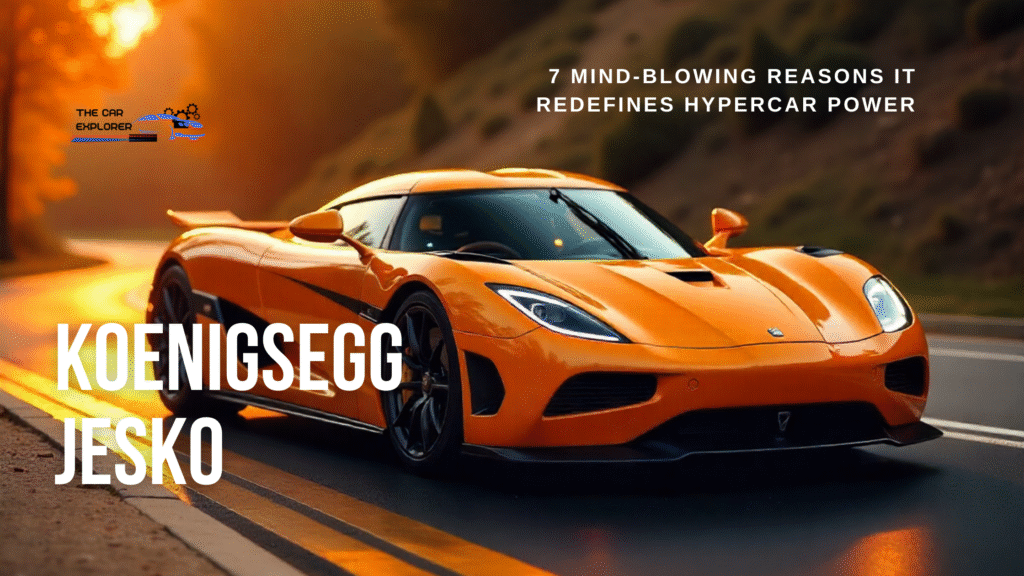Table of Contents
Introduction: Beauty Isn’t Always Easy to Live With
The Alfa Romeo 4C is a sort of car that will make you freeze on the street. It has an exotically mid-engine proportion, a mean set of curves, and a featherweight carbon-fiber construction, which makes it look like a smaller-sized supercar, even taken out of an Italian dream. It will give the rawest driving satisfaction, something which is hardly obtained in the current automobile environment, which is high-tech and heavy.

However, the fact that most people will not discuss with you is the fact that the Alfa Romeo 4C is not a car that you can own casually.
There are trade-offs supporting the flamboyant design and motor racing heritage, which render this car nearly perfect for everyday performance. Poorly coddled ride, not a single feature of modern conveniences: the 4C requires its driver to make serious sacrifices in the name of performance and purity.
In this article, we venture into the 7 ugly facts of owning the Alfa Romeo 4C, or rather, information that enthusiasts are not privy to, but every prospective buyer needs to know before making their decision.
1. Ride Quality That Punishes Your Spine
The Alfa Romeo 4C boasts a carbon fiber monocoque chassis, and this is one of the proud engineering achievements of the car, to say the very least. Usually, you do not see carbon fiber monocoque chassis on cars that cost tens of thousands of dollars. It makes the car so light (less than 2,500 lbs) and so sharp in corners. However, such motorsport-informed construction, together with highly tuned suspension, does not happen without compromise: the ride quality is all but invisible.
The 4C feels completely at home on the smooth canyon road or on a newly paved track, with every bump, curve, and throttle feedback being entered into your fingertips. There is a certain rush of feeling so close to asphalt. However, the very characteristics that make it exciting at high speeds also make it almost unbearable on the road.
Drive over a pothole, seam, or expansion joint, and you will feel it vibrating up your spine. The suspension yields little assimilation, the seats give little padding, and there is nothing that will cushion the impact, such as soundproofing. Releasing it on a daily basis implies consistently shaking it off at road inefficiencies, and as time goes by, such savagery can transform into tiresome instead of pleasure.
To weekend warriors or track-day fanatics, this could mean heaven. But when it comes to anyone who is thinking of purchasing the 4C as a commuter or daily driver, then the hard ride is a bitter wake-up call.
2. Minimal Cargo and Interior Storage
Alfa Romeo 4C is not only lightweight in its build but also lightweight in substance. It appears to be a proper grand touring sports car on the outside, but when you open the door (and when you open the trunk as well), it will start to become immediately evident how little usable space it has to offer.
You will receive a small amount of truck space in the rear of the car, only 3.7 cubes, a small duffel bag or one carry-on suitcase, and that is it. That’s it. No front “trunk” (or frunk), either, as that up-front area is taken up with suspension and crash structure parts.
The interior doesn’t do much better:
- No glove box
- No center console storage
- No traditional door pocket
- Just a few small cubbies for the bare essentials
What this translates to is that all modernity, such as carrying your sunglasses or your wallet and even a water bottle, could be a juggling experience.
Although this kind of streamlining allows not just carrying weight but also provides a purist with a pure driving sensation, this trend renders the 4C entirely wrong as the vehicle to call upon in situations when making a long road trip or carrying out some practical activity is necessary. Ultra light packing is needed when one takes weekend trips, and even when someone has to just go to the grocery this can be an effort.
You can clearly see that the Alfa Romeo 4C is designed to have spirited Sunday fun rather than a real working car- an issue every potential buyer must be willing to live with.
3. Steering So Pure, It’s Actually Unforgiving

The fourth thing that makes the Alfa Romeo 4C so lauded is its steering feel, and rightfully so. The vehicle employs a manual and unassisted steering rack, implying that there is no power steering motor to dampen out the feeling between the tires on the front of the car, along with your hands. The outcome is uncivilized, industrial-like feedback left all but dead in contemporary sports automobiles.
In motion, it is fantastic. You experience all the subtleties of the road surface: all the camber and grip or slither. It is a type of physical encounter that extreme driving purists visualize in their dreams.
However, it has a drawback: one can exercise at slow speeds.
The 4C can be quite difficult to park or maneuver into tight turns in a city location, without power assist, and making use of lots of arm strength and patience. Parking in a parking garage or U-turning in narrow streets is a hassle, and it is compounded by the car having a huge turning radius and the rear view being bad.
This makes the 4C tiring to operate in stop-and-go metropolitan conditions, and to ordinary motorists, it may seem a lot of work rather than rewarding. That is a characteristic that pits the hardcore enthusiast against those who just want a more comfortable and forgiving weekend toy.
Basically, the raw steering is a curse and a blessing all at once: It is something that you will never forget about the 4C, but it is also the one reminding that the car was not designed to be convenient.
4. Cabin Noise Can Be Overwhelming
Get into the Alfa Romeo 4C, and the first thing you are going to notice is what is lacking: insulation. Nothing is cushioned or carpeted, nothing is muffled or panelled, and the mechanical soundtrack, beating against your skull, inches behind your ears, is not concealed. The cabin is a stiff, filthy, undiluted echo chamber and remains so regardless of whether you are cruising or canyon carving.
The result? Noise—lots of it.
- The engine note is exciting with the full throttle, but on the highway speeds, it drones at high decibels.
- There is roaring of tires and wind noise that seeps in, especially at high speeds.
- A Bluetooth phone conversation or just a talk will simply want shouting most of the time.
This sound-savage atmosphere is going to sing to the ears of track-day purists in search of immersion. However, in the real world, during commutes or longer trips, it is simply exhausting to drive–particularly when juxtaposed against some more affordable cars with a similar price but better balance between driving performance and comfort.
As opposed to the present-day sports cars that isolate you against the pandemonium, the 4C puts you in the middle of it. You have no intermediary between you and the mechanical violence beneath the skin, and such intimacy is both thrilling (at least) and fatiguing (according to your expectations).
In case you appreciate quietness, then the Alfa Romeo 4C may be of challenge to you. However, when it comes to living each and every rev and vibration, then this weakness may seem to be part of the fun.
5. Limited Aftermarket Support and Tech Features
Even though a good number of sports car owners enjoy customizing and upgrading their cars, it leaves little in terms of tech-savvy or performance-starved customization options in the Alfa Romeo 4C. Actually, the aftermarket support is surprisingly low on it as well, compared to a more common car such as the Mazda Miata, Porsche Cayman, or BMW M cars.
The tech experience in the cabin is very minimal:
- No touchscreen interface
- The simple radio with an outdated interface
- Bluetooth is just for making and receiving calls and music with uneven connection stability
- No, Apple CarPlay, Android Auto, or voice control
Even simple cars of 10 years ago have more features and comfort compared to the 4C. It lacks many creature comforts that you might be accustomed to with a modern car, and that might be disheartening when suddenly you have to do without power windows, power seats, etc.
It is also difficult to modify the car. Body and suspension modifications are restrictive to the 4C in discarding the carbon monocoque chassis, and there are not many tuning houses that utilize it. You will not go through endless offerings in an aftermarket catalog, or find an enormous online community to exceed your support needs like the Miata or the 911.
This is one car that you need to drive as is; it is raw, basic, and remains unaltered, and as such, it is something that may be frustrating to some enthusiasts.
6. Costly Maintenance and Replacement Parts
In name, the Alfa Romeo 4C has a 1.75L turbocharged four-cylinder EURO 5 engine, an engine that would appear to be a low-cost running engine. Yet, in an actual sense, everything around the engine is exotic, and the maintenance bill is not left out.
It is all due to the carbon fiber carcass, aluminum subframes, and custom Italian parts that make even normal maintenance costly. Here’s why:
- The oil and fluids procedures demand particular components and manpower from Alfa specialists
- The tires and the brakes are high-performance spec, and they are sometimes not in stock
- Body panels, along with carbon fiber trim, are terribly expensive to fix or replace
Better yet, very few Alfa Romeo mechanics are qualified to work on these cars, particularly in small cities or far-flung locations where dealers are not available. There are more labor hours, and the waiting periods may be longer than they should be.
An accident as little as a fender-bender can run thousands. Although reliability is sufficiently good, the limited number of parts and skilled technicians also implies that the owners must worry about downtime and the fear of repair.
To conclude, the 4C might be compact, but it does not have supercar-sized maintenance, which is a bitter disappointment to those who anticipate maintaining a car with low costs.
7. It’s Not Being Made Anymore—Which Cuts Both Ways

Alfa Romeo 4C formally exited most markets in 2020 and stopped production altogether of the coupe body and the Spider version. Although there were some last production versions and local models issued, a direct successor is not planned. That is why the 4C is a very peculiar breed in the world of cars.
This exclusivity is a two-edged sword.
On the one hand, it will be discontinued, which creates doubts:
- The availability of long-term parts can be a problem, particularly for carbon fiber parts and any proprietary electronics.
- Service and support might become less substantial since Alfa will move to newer models such as the Tonale or electric platforms.
- The resale value can be unstable, particularly when the car passes out of the mainstream visibility.
Still, on the other hand, rarity can enhance the attractiveness of the 4C:
- It is already acquiring the reputation of being a future collectible due to its lightweight design, unusual appearance, and purity of analog driving experience.
- There were only a few ever produced, particularly in the U.S, and this is seen by the 4C enthusiasts and collectors regard them as a new era classic.
- It is also a fact that it became the last Alfa to apply the carbon fiber monocoque, which makes the car unique.
Therefore, scary though it may be to own a discontinued car, the scarcity of the Alfa Romeo 4C may eventually turn out to be its greatest strong point. All you have to do is live with the bugs.
Conclusion: A Flawed Gem for the Passionate Driver
Make no mistake, the Alfa Romeo 4C is not an ordinary sports car; it is a mid-engined adrenaline car whose main purpose is to bring the purity. It does not pamper you in tech, storage, or ride. It is therefore just raw feedback, pinpoint control, and a solid feel of the road that very few cars at its price could readily compete with.
However, this experience has its price tag. The 4C is a car that needs sacrifice; in suspension, it is spine-jarring, in utility, it is all but nonexistent. It is a car that is rewarding to drive, but driving it daily is a punishment.
Assuming your heart, and not your head, is doing the shopping–and you would be happy to own a decent-but-almost-forgotten machine–then the Alfa Romeo 4C may be your dream weekend warrior. It is not going to make your life easy.
For more info: Click Here.
FAQs
Is the Alfa Romeo 4C worth investing in?
The 4C has been taking the appeal in the collector world because of its lightness, carbon fiber structure, and the analog feeling of the drive. Prices are stable- and even increasing as the contemporary sports cars are more digitalized and automated.
What is the reliability of the Alfa Romeo 4C?
It is mechanically sound as long as it is well-maintained. But, electrical weirdness and a lack of dealership knowledge can be a hassle in ownership. It is highly advisable to service an Alfa specialist on a regular basis.
Is the Alfa Romeo 4C a daily driver?
It can, but the majority of the owners would not advise it. It has problems with a harsh ride, a loud cabin, a small amount of storage, and sorely misses any modern features, so it is not a good purchase to use as a daily yada-yada runner.



